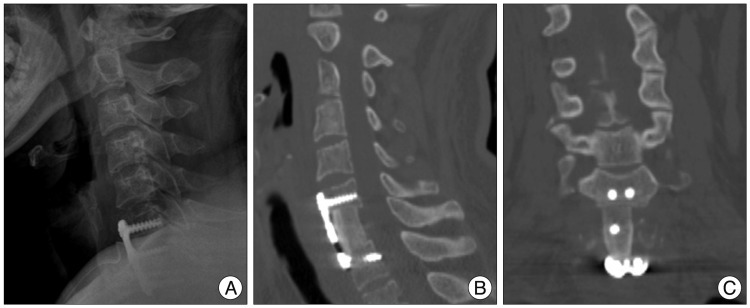1. Azouz EM, Saigal G, Rodriguez MM, Podda A. Langerhans' cell histiocytosis : pathology, imaging and treatment of skeletal involvement. Pediatr Radiol. 2005; 35:103–115. PMID:
15289942.

2. Bertram C, Madert J, Eggers C. Eosinophilic granuloma of the cervical spine. Spine (Phila Pa 1976). 2002; 27:1408–1413. PMID:
12131737.

3. Brown CW, Jarvis JG, Letts M, Carpenter B. Treatment and outcome of vertebral Langerhans cell histiocytosis at the Children's Hospital of Eastern Ontario. Can J Surg. 2005; 48:230–236. PMID:
16013628.
4. Bunch WH. Orthopedic and rehabilitation aspects of eosinophilic granuloma. Am J Pediatr Hematol Oncol. 1981; 3:151–156. PMID:
7304858.

5. Glotzbecker MP, Carpentieri DF, Dormans JP. Langerhans cell histiocytosis : a primary viral infection of bone? Human herpes virus 6 latent protein detected in lymphocytes from tissue of children. J Pediatr Orthop. 2004; 24:123–129. PMID:
14676546.
6. Howarth DM, Gilchrist GS, Mullan BP, Wiseman GA, Edmonson JH, Schomberg PJ. Langerhans cell histiocytosis : diagnosis, natural history, management, and outcome. Cancer. 1999; 85:2278–2290. PMID:
10326709.
7. Huang W, Yang X, Cao D, Xiao J, Yang M, Feng D, et al. Eosinophilic granuloma of spine in adults : a report of 30 cases and outcome. Acta Neurochir (Wien). 2010; 152:1129–1137. PMID:
20396916.

8. Islinger RB, Kuklo TR, Owens BD, Horan PJ, Choma TJ, Murphey MD, et al. Langerhans' cell histiocytosis in patients older than 21 years. Clin Orthop Relat Res. 2000; 231–235. PMID:
11039811.

9. Jang KS, Jung YY, Kim SW. Langerhans cell histiocytosis causing cervical myelopathy in a child. J Korean Neurosurg Soc. 2010; 47:458–460. PMID:
20617093.

10. Jiang L, Liu ZJ, Liu XG, Zhong WQ, Ma QJ, Wei F, et al. Langerhans cell histiocytosis of the cervical spine : a single Chinese institution experience with thirty cases. Spine (Phila Pa 1976). 2010; 35:E8–E15. PMID:
20042947.
11. Kilborn TN, Teh J, Goodman TR. Paediatric manifestations of Langerhans cell histiocytosis : a review of the clinical and radiological findings. Clin Radiol. 2003; 58:269–278. PMID:
12662947.

12. Lichtenstein L. Histiocytosis X; integration of eosinophilic granuloma of bone, Letterer-Siwe disease, and Schüller-Christian disease as related manifestations of a single nosologic entity. AMA Arch Pathol. 1953; 56:84–102. PMID:
13057466.
13. Peng XS, Pan T, Chen LY, Huang G, Wang J. Langerhans' cell histiocytosis of the spine in children with soft tissue extension and chemotherapy. Int Orthop. 2009; 33:731–736. PMID:
18338168.

14. Richter MP, D'Angio GJ. The role of radiation therapy in the management of children with histiocytosis X. Am J Pediatr Hematol Oncol. 1981; 3:161–163. PMID:
7030100.

15. Sayhan S, Altinel D, Erguden C, Kizmazoglu C, Guray M, Acar U. Langerhans cell histiocytosis of the cervical spine in an adult : a case report. Turk Neurosurg. 2010; 20:409–412. PMID:
20669118.
16. Scarpinati M, Artico M, Artizzu S. Spinal cord compression by eosinophilic granuloma of the cervical spine. Case report and review of the literature. Neurosurg Rev. 1995; 18:209–212. PMID:
8570070.

17. Seimon LP. Eosinophil granuloma of the spine. J Pediatr Orthop. 1981; 1:371–376. PMID:
7334115.

18. Simanski C, Bouillon B, Brockmann M, Tiling T. The Langerhans' cell histiocytosis (eosinophilic granuloma) of the cervical spine: a rare diagnosis of cervical pain. Magn Reson Imaging. 2004; 22:589–594. PMID:
15120180.

19. Tan G, Samson I, De Wever I, Goffin J, Demaerel P, Van Gool SW. Langerhans cell histiocytosis of the cervical spine : a single institution experience in four patients. J Pediatr Orthop B. 2004; 13:123–126. PMID:
15076592.

20. Vadivelu S, Mangano FT, Miller CR, Leonard JR. Multifocal Langerhans cell histiocytosis of the pediatric spine : a case report and literature review. Childs Nerv Syst. 2007; 23:127–131. PMID:
17021733.

21. Wei MA, Ruixue MA. Solitary spinal eosinophilic granuloma in children. J Pediatr Orthop B. 2006; 15:316–319. PMID:
16891956.

22. Yeom JS, Lee CK, Shin HY, Lee CS, Han CS, Chang H. Langerhans' cell histiocytosis of the spine. Analysis of twenty-three cases. Spine (Phila Pa 1976). 1999; 24:1740–1749. PMID:
10472109.
23. Zhong WQ, Jiang L, Ma QJ, Liu ZJ, Liu XG, Wei F, et al. Langerhans cell histiocytosis of the atlas in an adult. Eur Spine J. 2010; 19:19–22. PMID:
19844749.






 PDF
PDF ePub
ePub Citation
Citation Print
Print





 XML Download
XML Download